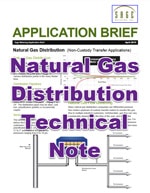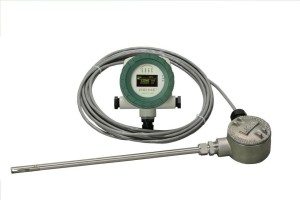Gas flares are used in various activities, including natural gas production and distribution, oil refineries, chemical plants, biogas, wastewater treatment, and the steel industry. In these applications, thermal mass flow meters are ideal for measuring the gas flow.
In the market for a mass flow meter?

A gas flare (flare stack) is a combustion safety device that burns off an excess gas or unintentionally released flammable material. Without flaring, the combustible material releases into the atmosphere creating the potential for an accidental explosion. Flares are used in gas production and oil refineries. However, they are also found in many other industries, including wastewater treatment plants and the steel industry.
Any process or industrial facility which produces flammable material should have a flare as part of their safety system. The composition of gas depends on the industry and application.
Natural Gas Production and Distribution
 Natural gas is often present with crude petroleum oil. Many times, especially in offshore oil platforms, there is no system to handle natural gas. As a result, the natural gas is separated from the oil and burnt in a flare. Flares are at gas wellheads at on-shore locations and used during drilling, maintenance, and in upset conditions.
Natural gas is often present with crude petroleum oil. Many times, especially in offshore oil platforms, there is no system to handle natural gas. As a result, the natural gas is separated from the oil and burnt in a flare. Flares are at gas wellheads at on-shore locations and used during drilling, maintenance, and in upset conditions.
In upstream oil production fields, flares are used on vents from oil storage tanks. The composition of the gas from the oil storage tanks may vary due to the various hydrocarbons evaporating from the oil. At a gas wellhead or compressor station, the gas is natural gas.
Oil Refineries Applications
Oil refineries use an extensive flare system for the collection of all combustible gases. During regular operation, there is some sweep or purge gas intended to maintain a slight positive pressure in the flare headers. The purge gas prevents the entry of air (oxygen) into the flare system as a safety measure to avoid creating a dangerous condition. The flow rate of the sweep is very low. If there is an upset or over-pressurization, the relief valves will open, and gas from a processing unit will flow into the flare system. The composition of the gas will vary depending on the unit in the refinery; this variation creates some challenges in using thermal mass flow meters.
Biogas Applications
A wastewater treatment plant may have a digester that produces a form of biogas. Biogas is also present in landfill operations and waste-to-energy plants. Usually, these facilities will use the biogas as a fuel for an engine to produce energy which may be used on-site or exported. However, the biogas may flare if production exceeds the engine’s capability or the equipment is shut down for maintenance, or an upset condition occurs.
Steel Industry Applications

The steel industry uses Coke Ovens, basic oxygen furnaces, and the blast furnaces which produce combustible gases, sometimes referred to as steel production gases. These gases contain large amounts of carbon monoxide and hydrogen, which can be burned in an engine to generate power for the mill. In the event of an upset or during equipment maintenance, the gases are sent to a flare.
Flare Gas Flow Meter Requirements:
In all these flare applications, the need exists to measure a continual low velocity of gas and then be able to measure a sudden increase in the flow rate if there is a release to the flare system. A thermal mass flow meter has very high turndown capabilities, which can measure both the low and high-velocity gases. Also, the thermal mass flow meter is easy to install in the flare header, does not need pressure and temperature correction, creates virtually no pressure drop, and provides high reliability.
The performance of a thermal mass flow meter is dependent on gas composition; variations in gas composition can affect operation. Sage Metering can provide estimations of performance variations with different gas compositions.
More Information Available
If you would like more information on addressing the inherent challenges associated with measuring flare gas, read the Sage white paper, Measurement Using Sage Thermal Mass Flow Meters.

